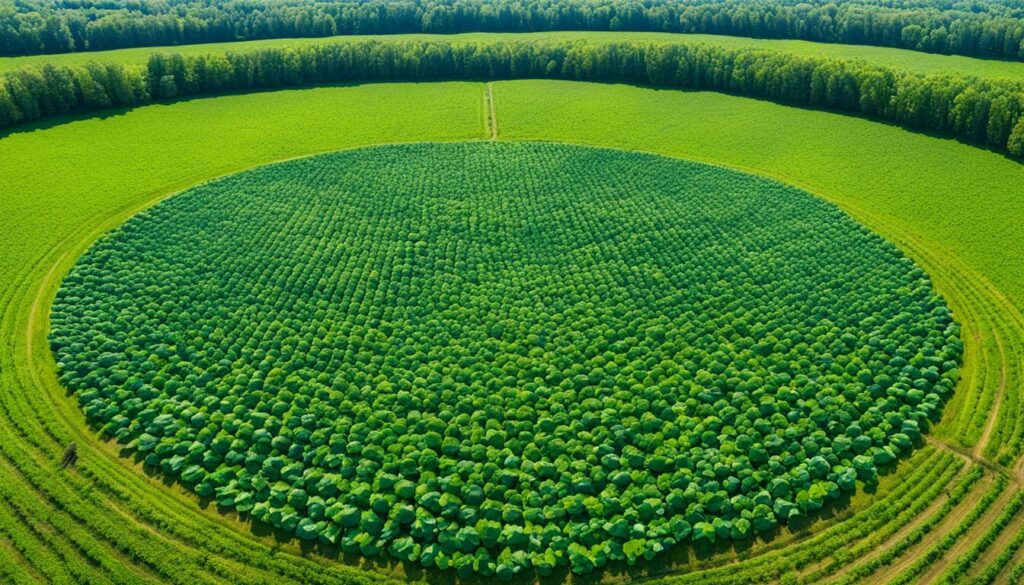To attract deer to your property and create a thriving deer population, there are several strategies you can implement.
These strategies include improving deer habitat, implementing food plots, using deer attractants, practicing deer scent control, providing proper deer feeding tips, using deer baiting techniques, landscaping for deer, creating a deer-friendly environment, and implementing effective deer management practices.
Improve Deer Habitat
Improving the habitat on your property is crucial for attracting deer. This involves creating a deer-friendly environment by implementing proper landscaping practices. Planting shrubs and vines, such as honeysuckle and grape, can provide food and cover for deer.
Additionally, planting native warm-season grasses like switchgrass can benefit deer and other wildlife species. Creating a diverse habitat with suitable food sources, cover, and bedding areas will make your property more appealing to deer.
Benefits of Proper Landscaping for Deer
Planting shrubs and vines, such as honeysuckle and grape, provides deer with food and cover. These plants also attract insects, an essential part of a deer’s diet, especially during summer.
Additionally, planting native warm-season grasses like switchgrass offers valuable cover and bedding areas for deer and other wildlife.
Creating a Diverse Habitat
To attract deer, it’s essential to create a diverse habitat that offers a variety of food sources and cover. This can be achieved by incorporating different vegetation types, such as trees, shrubs, grasses, and flowering plants.
Strategic Placement of Food Sources and Cover
When landscaping for deer, it’s essential to consider the strategic placement of food sources and cover.
For example, you can plant fruit-bearing trees or bushes near open areas to provide a readily available food source for deer. Similarly, creating thickets or dense vegetation patches can offer shelter and security for deer.
Recommended Plants for Deer Habitat Improvement
| Plant Type | Recommended Species |
|---|---|
| Trees | White oak, red oak, apple, pear |
| Shrubs | Honeysuckle, raspberry, blackberry, spicebush |
| Grasses | Switchgrass, Indian grass, little bluestem |
| Flowering Plants | Goldenrod, aster, milkweed, bee balm |
Implement Food Plots
Food plots are crucial in attracting and providing essential nutrition for deer on your property. When designing your food plots, it’s essential to consider the types of plants that deer prefer.
To create a successful food plot, aim for a 60% cold-season perennials ratio, 20% cold-season annuals, and 20% warm-season annuals. This variety of plants will offer a continuous and reliable food supply, catering to the changing nutritional needs of deer in different seasons.

| Food Plot Strategy | Description |
|---|---|
| Ratio of Plants | 60% cold-season perennials 20% cold-season annuals 20% warm-season annuals |
| Location | Plant food plots near bedding areas |
| Entry and Exit Routes | Create discreet routes to minimize spooking deer |
Use Deer Attractants
Attracting deer to your property can be achieved by utilizing effective deer attractants. These attractants not only lure deer to specific areas but also provide them with essential minerals and nutrients they need for optimal health and well-being.
Some commonly used deer attractants include:
- Mineral Sites: Establishing mineral sites can be a great way to attract deer. These sites are enriched with minerals like calcium and phosphorus, crucial for healthy antler growth and overall deer development.
- Salt Licks: Salt licks act as powerful attractants, as deer are naturally drawn to the salt for its essential minerals. By strategically placing salt licks throughout your property, you can entice deer to visit and spend more time on your land.
- Mock Scrapes: Creating mock scrapes imitates the behavior of deer during the mating season. Using a combination of urine, gland scents, and natural deer attractants, you can replicate the presence of other deer, thus attracting more deer to your property.
| Deer Attractants | Benefits |
|---|---|
| Mineral Sites | – Provides essential minerals for healthy deer development – Enhances antler growth |
| Salt Licks | – Attracts deer due to the essential minerals in salt – Keeps deer on your property for longer durations |
| Mock Scrapes | – Mimics deer behavior during the mating season – Attracts nearby deer by simulating the presence of other deer |
Proper Scent Control Tips
- Use scent-free cleaning products and laundry detergents when washing your hunting clothes and gear.
- Avoid using scented personal care products, such as perfumes or colognes, before heading to your deer hunting spot.
- Store your hunting clothes and gear in sealed bags or containers with scent-eliminating products.
- Keep human contact to a minimum when you plan to use deer attractants.
- Use scent-eliminating sprays or wipes to reduce any residual human scent that may be present.
Implement Deer Baiting Techniques
In some areas where baiting is legal, implementing deer baiting techniques can effectively attract deer. This involves placing bait such as corn or apples in designated areas to entice deer to visit your property.
Researching and following the regulations and guidelines for deer baiting in your location is essential to ensure you are following the law.
The Benefits of Deer Baiting Techniques
Deer baiting techniques can offer several advantages for attracting deer to your property:
Increased deer activity: By strategically placing bait in designated areas, you can significantly increase deer activity on your property. This enhances your chances of seeing more deer and creates opportunities for successful hunting or wildlife observation.
Targeted deer feeding: Baiting allows you to provide a concentrated food source for deer. This can be particularly beneficial when natural food is scarce, such as late winter or early spring. You can help deer maintain their health and vitality by supplementing their diet with bait.
Effective scouting: Baiting sites can serve as valuable scouting locations. By regularly monitoring baited areas, you can gather important information about deer behavior, activity patterns, and the overall health of the local deer population.
Table:
| Deer Baiting Techniques | Benefits |
|---|---|
| Strategically placing bait | Increased deer activity and targeted feeding |
| Monitoring baited areas | Effective scouting and gathering valuable information |
Create an Optimal Deer-Friendly Environment
In addition to implementing habitat improvements and using attractants, creating an optimal deer-friendly environment requires the implementation of proper deer management practices.
These practices involve managing the deer population through hunting, maintaining suitable cover and food sources, and providing water.
Managing the deer population is essential for maintaining a balanced ecosystem and creating an environment that is attractive to deer.
Maintaining suitable cover and food sources is crucial for attracting and keeping deer on your property. This can be achieved through proper landscaping techniques and strategically planting vegetation that deer find appealing.
Water sources are also important for deer, requiring water for hydration and survival. Natural or artificial water sources can be incorporated into your property to provide a reliable water source for deer. Consider placing these water sources near areas where deer frequent, such as bedding areas or food plots, to increase the likelihood of attracting deer.
Consider Water Sources
Water sources are essential for attracting and maintaining a healthy deer population. Providing deer with a reliable water source is crucial for their survival and plays a vital role in attracting them to your property.
Whether you choose natural or artificial water sources, strategically placing them throughout your property can significantly increase the chances of attracting deer.
When implementing water sources, consider the landscaping of your property. Ensure that the water sources are placed where deer commonly frequent, such as near bedding areas or along travel routes.

Conclusion
Attracting deer to your property requires a combination of effective strategies and proper deer management practices.
Additionally, incorporating food plots with various plants that deer prefer will ensure a continuous food source throughout the year. Deer attractants like mineral sites and salt licks can further entice deer to visit your property.
Practicing deer scent control and minimizing human presence is essential to avoid alerting deer to your activities. Implementing deer baiting techniques, where legal, can also be a successful way to attract deer to specific areas of your property. Remember to research and adhere to deer baiting regulations in your location.
